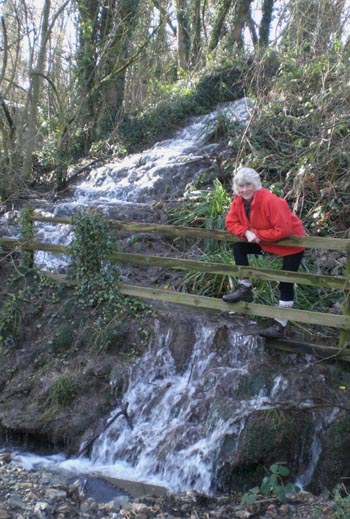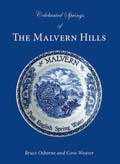
| 
|


Railway Tunnel Spring
NGR 77593 43695
Site Number: C81
By Bruce Osborne and Cora Weaver (C) 2012
Area 5. Malvern Wells Area Springs and Wells
Malvern Hills, England
Description: a substantial volume of water emerging from the eastern end of a disused railway tunnel.
Today this torrent runs to waste and is probably ignored, but there was a time when it was a vital asset to Malvern Wells, Great Malvern and Malvern Link. To find it, take the A449 (Wells Road) south from Great Malvern. At the Railway Inn turn left into Peachfield Road, then first right into King Edward's Road, then immediately left into Fruitlands. The road curves round to the right, then to the left. Immediately after Juniper Way on the right is a bridleway that runs under the railway. Walk down the bridleway to the bridge. The outfall from the spring is on the right.
This prolific spring was discovered in 1852 during the boring for the building of the first tunnel through the hills, which opened in 1861.[1] The spring is about a third of the way into the western end of the old tunnel, where the Silurian beds are faulted against the Pre Cambrian, and where hydropathist and fossil-collector Dr Ralph Grindrod found a vast array of trilobites. About a third of the way inside the tunnel was a large room with a boiler and steam engine that pumped water from the spring to a tank almost above the tunnel. The steam pump was likely a reciprocating Weir type pump rather than a rotary pump. This supplied several homes locally as compensation for springs that were lost when the tunnel was built.
In Great Malvern the Davenham Estate in Graham Road made good use of this Great Western Railway supply. The tunnel water also supplied the railway stations at Malvern Wells, Great Malvern and Malvern Link, and it fed water towers at Malvern Wells and Malvern Link bridge where steam engines could take on water. The water supply to the three Malvern stations was by 6 inch gravity main. Malvern Link Station was used for excursions with the impressive Great Malvern Station being reserved for the more exclusive patrons of the town. Malvern Wells station no longer exists. The source also supplied The Malvern Link Hotel, including its swimming pool. The hotel is illustrated in Hurle.[3] It was later a school but was demolished and replaced with a block of flats. The Imperial Hotel in Avenue Road, later the Malvern Girls' College, also had a water tower and a swimming pool fed by the spring. The Imperial Hotel also received a supply of Droitwich Brine water which was specially transported in by railway. In June 1896 'The most destructive fire that ever occurred in Malvern proper broke out...' at the Imperial Hotel, causing extensive damage estimated at ten thousand pounds. The fire brigade had the most rudimentary, hand operated equipment and the fire took hours to put out. It was agreed that the tunnel water was most effective in putting out the fire. Following this a new steam engine was acquired in July 1897 by the fire service.
Unfortunately, due to the steam locomotives taking all the oxygen in the tunnel, there was a danger that the train drivers would become unconscious, so when a new tunnel opened in 1927 the earlier tunnel closed. The little pumping station became redundant in 1927 when the second tunnel opened and the tank was abandoned in favour of mains water.
Today, near the eastern portals of the tunnels, there is a large iron tank full of tunnel water, which is believed to feed the trackside main. The main beneficiary of the tunnel water today is the golf course at Malvern Wells. A cistern by the railway bridge is still used for watering the greens, and the substantial outfall of water that emerges near the railway bridge runs across the golf course as a brook. There is also a modest spout at ground level on the northern side of the bridge.
Illustrations:
1. The main spring outfall in 2013.
Additional Information:
High on the hills near the Wyche Cutting there is an ancient iron vent pipe thought to have been part of the ventilation system for the pumping engine. and late nineteenth century maps mark an aqueduct and tanks in the vicinity of the Link station.
Footnotes:
[1] Jenkins 1969 p.16.
[2] Malvern Advertiser, 9 Feb 1895.
[3] Hurle 1985 p.81.

Website: Click Here
SUPPLEMENTARY INFORMATION

Celebrated Springs of
THE MALVERN HILLS
 A definitive work that is the culmination of 20 years researching the springs and wells of the Malvern Hills, published by Phillimore. This is the ideal explorers guide enabling the reader to discover the location and often the astounding and long forgotten history of over 130 celebrated springs and wells sites around the Malvern Hills. The book is hard back with dust cover, large quarto size with lavish illustrations and extended text. Celebrated Springs contains about 200 illustrations and well researched text over a similar number of pages, together with seven area maps to guide the explorer to the locations around the Malvern Hills. It also includes details on the long history of bottling water in the Malvern Hills.
A definitive work that is the culmination of 20 years researching the springs and wells of the Malvern Hills, published by Phillimore. This is the ideal explorers guide enabling the reader to discover the location and often the astounding and long forgotten history of over 130 celebrated springs and wells sites around the Malvern Hills. The book is hard back with dust cover, large quarto size with lavish illustrations and extended text. Celebrated Springs contains about 200 illustrations and well researched text over a similar number of pages, together with seven area maps to guide the explorer to the locations around the Malvern Hills. It also includes details on the long history of bottling water in the Malvern Hills.
Written by Bruce Osborne and Cora Weaver, this book is available on-line for £15.00 (delivered UK) - click Malvern Bookshop on the green panel top left. Alternatively send a cheque payable to Cora Weaver with your name and address to 4 Hall Green, Malvern, Worcs. WR14 3QX.
1) TOPOGRAPHICAL LOCATION:
Malvern Hills - arguably Britain's original National Park
2) LANDSCAPE:
Rolling Countryside3) INFORMATION CATEGORY:
A Spring, Spout, Fountain or Holy Well Site4) MALVERN SPRING OR WELL SITE DETAILS:
Site with Malvern Water4 SPLASHES - Well Worth Finding

5) GENERAL VISITOR INFORMATION:
Access On FootFree Public Access
Free Parking Nearby
Accessible All Year


